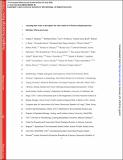Files in this item
Assessing host-virus codivergence for close relatives of Merkel cell polyomavirus infecting African great apes
Item metadata
| dc.contributor.author | Madinda, Nadège F. | |
| dc.contributor.author | Ehlers, Bernhard | |
| dc.contributor.author | Wertheim, Joel O. | |
| dc.contributor.author | Akoua-Koffi, Chantal | |
| dc.contributor.author | Bergl, Richard A. | |
| dc.contributor.author | Boesch, Christophe | |
| dc.contributor.author | Akonkwa, Dieudonné Boji Mungu | |
| dc.contributor.author | Eckardt, Winnie | |
| dc.contributor.author | Fruth, Barbara | |
| dc.contributor.author | Gillespie, Thomas R. | |
| dc.contributor.author | Gray, Maryke | |
| dc.contributor.author | Hohmann, Gottfried | |
| dc.contributor.author | Karhemere, Stomy | |
| dc.contributor.author | Kujirakwinja, Deo | |
| dc.contributor.author | Langergraber, Kevin | |
| dc.contributor.author | Muyembe, Jean Jacques | |
| dc.contributor.author | Nishuli, Radar | |
| dc.contributor.author | Pauly, Maude | |
| dc.contributor.author | Petrzelkova, Klara J. | |
| dc.contributor.author | Robbins, Martha M. | |
| dc.contributor.author | Todd, Angelique | |
| dc.contributor.author | Schubert, Grit | |
| dc.contributor.author | Stoinski, Tara S. | |
| dc.contributor.author | Wittig, Roman M. | |
| dc.contributor.author | Zuberbühler, Klaus | |
| dc.contributor.author | Peeters, Martine | |
| dc.contributor.author | Leendertz, Fabian H. | |
| dc.contributor.author | Calvignac-Spencer, Sébastien | |
| dc.date.accessioned | 2019-01-29T10:30:05Z | |
| dc.date.available | 2019-01-29T10:30:05Z | |
| dc.date.issued | 2016-10 | |
| dc.identifier | 246928885 | |
| dc.identifier | bd0d36a7-a96c-4e2f-afd0-da9f68347906 | |
| dc.identifier | 84990198224 | |
| dc.identifier | 000383761900014 | |
| dc.identifier.citation | Madinda , N F , Ehlers , B , Wertheim , J O , Akoua-Koffi , C , Bergl , R A , Boesch , C , Akonkwa , D B M , Eckardt , W , Fruth , B , Gillespie , T R , Gray , M , Hohmann , G , Karhemere , S , Kujirakwinja , D , Langergraber , K , Muyembe , J J , Nishuli , R , Pauly , M , Petrzelkova , K J , Robbins , M M , Todd , A , Schubert , G , Stoinski , T S , Wittig , R M , Zuberbühler , K , Peeters , M , Leendertz , F H & Calvignac-Spencer , S 2016 , ' Assessing host-virus codivergence for close relatives of Merkel cell polyomavirus infecting African great apes ' , Journal of Virology , vol. 90 , no. 19 , pp. 8531-8541 . https://doi.org/10.1128/JVI.00247-16 | en |
| dc.identifier.issn | 0022-538X | |
| dc.identifier.other | ORCID: /0000-0001-8378-088X/work/64360642 | |
| dc.identifier.uri | https://hdl.handle.net/10023/16949 | |
| dc.description | This work, including the efforts of Klara Judita Petrzelkova, was funded by Academy of Sciences of the Czech Republic (RVO68081766). This work, including the efforts of Klara Judita Petrzelkova, was funded by Grant Agency of the Czech Republic (206/09/0927). This work, including the efforts of Joel O. Wertheim, was funded by University of California Laboratory Fees Research Program (12-LR-236617). This work, including the efforts of Joel O. Wertheim, was funded by HHS | National Institutes of Health (NIH) (K01-AI110181). This work, including the efforts of Martine Peeters, was funded by Agence Nationale de Recherches sur le Sida et les Hepatites Virales (ANRS) (12125, 12182, 12555, and 12325). | en |
| dc.description.abstract | It has long been hypothesized that polyomaviruses (PyV; family Polyomaviridae) codiverged with their animal hosts. In contrast, recent analyses suggested that codivergence may only marginally influence the evolution of PyV. We reassess this question by focusing on a single lineage of PyV infecting hominine hosts, the Merkel cell polyomavirus (MCPyV) lineage. By characterizing the genetic diversity of these viruses in seven African great ape taxa, we show that they exhibit very strong host specificity. Reconciliation analyses identify more codivergence than noncodivergence events. In addition, we find that a number of host and PyV divergence events are synchronous. Collectively, our results support codivergence as the dominant process at play during the evolution of the MCPyV lineage. More generally, our results add to the growing body of evidence suggesting an ancient and stable association of PyV and their animal hosts. | |
| dc.format.extent | 11 | |
| dc.format.extent | 955710 | |
| dc.language.iso | eng | |
| dc.relation.ispartof | Journal of Virology | en |
| dc.subject | QH301 Biology | en |
| dc.subject | QR180 Immunology | en |
| dc.subject | QR355 Virology | en |
| dc.subject | Immunology | en |
| dc.subject | Virology | en |
| dc.subject | NDAS | en |
| dc.subject.lcc | QH301 | en |
| dc.subject.lcc | QR180 | en |
| dc.subject.lcc | QR355 | en |
| dc.title | Assessing host-virus codivergence for close relatives of Merkel cell polyomavirus infecting African great apes | en |
| dc.type | Journal article | en |
| dc.contributor.institution | University of St Andrews. School of Psychology and Neuroscience | en |
| dc.contributor.institution | University of St Andrews. Institute of Behavioural and Neural Sciences | en |
| dc.contributor.institution | University of St Andrews. Centre for Social Learning & Cognitive Evolution | en |
| dc.identifier.doi | 10.1128/JVI.00247-16 | |
| dc.description.status | Peer reviewed | en |
| dc.date.embargoedUntil | 2017-03-12 |
This item appears in the following Collection(s)
Items in the St Andrews Research Repository are protected by copyright, with all rights reserved, unless otherwise indicated.

